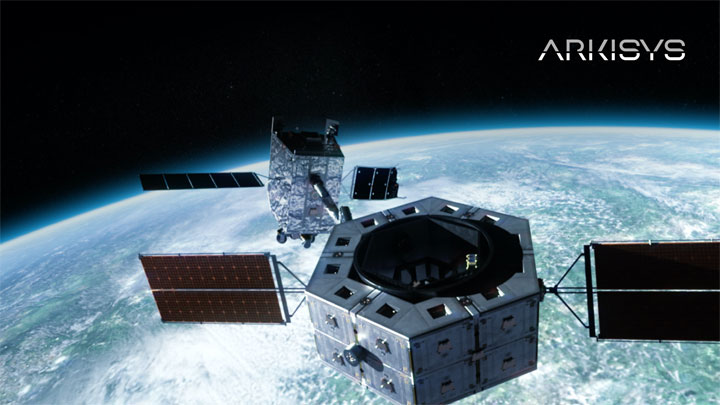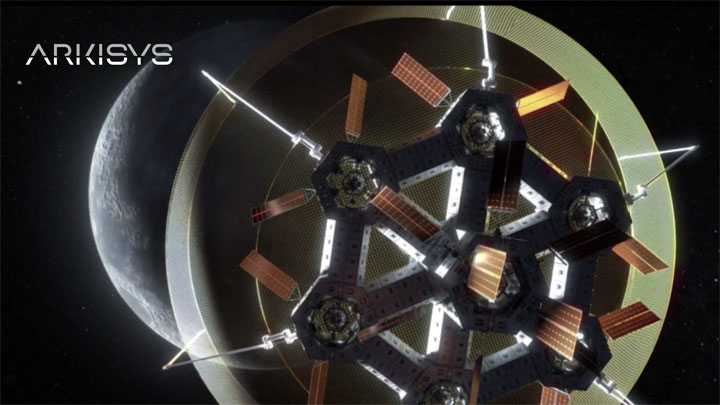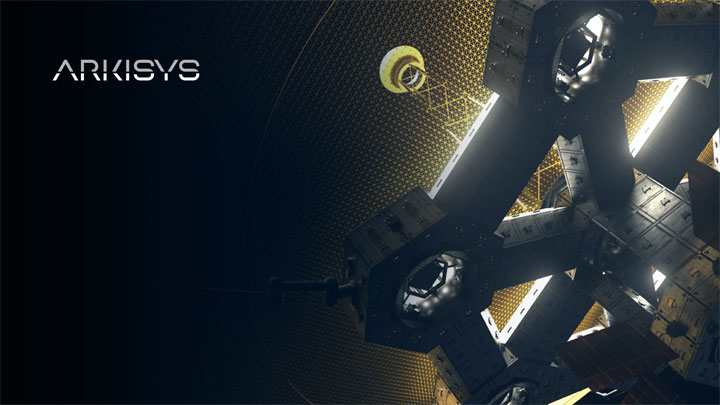ALEXANDRIA, Va. — The planned decommissioning of the International Space Station (ISS) by 2031 has kicked off the competition among commercial space companies to develop and deploy a replacement.
Blue Origin, Nanoracks and Northrop Grumman have been working with NASA on human-rated research facilities through the Commercial LEO Destinations program. Axiom Space aims to deploy its first station module by late 2024. Meanwhile, Voyager Space has partnered with Hilton on habitable, luxury space villas.
 Arkisys’ Port is under development as a commercial robotic space station for on-orbit manufacturing, research, experimentation as well as satellite assembly, manufacturing and deployment in space. (Source: Arkisys)
Arkisys’ Port is under development as a commercial robotic space station for on-orbit manufacturing, research, experimentation as well as satellite assembly, manufacturing and deployment in space. (Source: Arkisys)
Ensuring humans have a sustained presence off the planet is a critical capability and an enduring source of inspiration. At the same time, there is also momentum around robotic space stations to carry out the industrial, scientific and research activities that are better suited for machines than people.
“We love humans, but…there’s no way you’re manufacturing at scale and utilizing precious resources away from Earth when you have humans on board,” said Dan Lopez is the Chief Business Officer at Arkisys.
While other space tech companies vie to build the next crewed space module, Arkisys is developing a robotic, long-duration infrastructure-as-a-service (IaaS) platform in low-Earth orbit. The company’s platform, the Port, is part factory, part garage, part computing platform and part research lab.
The development of the Port coincides with the progress of in-space servicing, manufacturing and assembly (ISAM), which includes concepts for automated, robotic outposts.
Like Science Fiction?
Arkisys’ idea for the Port builds on the role of the seaport in modern and ancient life. It is envisioned as a place where spacecraft can dock, receive service, load and unload new technology payloads, while serving as an outpost for future long-distance trade routes.
The idea also borrows from the IaaS model exemplified by hyperscalers, like AWS, Microsoft Azure and others. The Port will leverage a scaleable digital platform and physical form that can be built on by private organizations, governments, researchers and nonprofits. Like other IaaS platforms, it will enable people to build innovations at a faster pace on top of an infrastructure that they don’t have to develop themselves, Lopez explained.
“It is literally unlocking the transplantation of industry and resources from Earth’s confines to be unbounded by that in space so you can take full industries and move them into orbit or off-world,” he said. “That seems like science fiction to some people, but it’s here.”
 Government and military organizations are fueling investments in robotic and human-rated space stations, as well as novel on-orbit capabilities. (Credit: Arkisys)
Government and military organizations are fueling investments in robotic and human-rated space stations, as well as novel on-orbit capabilities. (Credit: Arkisys)
Arkisys is several years into the process of developing, testing, building and deploying its platform. It was one of three companies to receive a study contract from the Defense Innovation Unit (DIU) in 2020 for rapid prototyping of an uncrewed orbital outpost. In March, Arkisys, along with partners Qediq Inc, Novawurks, Motive Space Systems, iBoss, and the Texas A&M Engineering Experiment Station, won a $1.6 million contract from SpaceWERX to demonstrate the ability to assemble and release a functional satellite in space, using the robotic Port Module.
“We’re well on our journey,” said Lopez, noting one of the first priorities was to build the digital engineering and modeling environment.
The company has a functional digital twin that it uses to dynamically simulate the environment in space and model interfaces with customer and partner payloads. Arkisys aims to deploy one of its Cutter-Class space vessels by next year to assist with rendezvous and other functions. The full Port Module is slated for deployment in 2026.
The Importance of Interfaces
One of the fundamental features of a commercial space station is its accessibility across organizations, governments and institutions. That starts with the design of standardized interfaces that enable everything from payload hosting and data exchange to supporting rendezvous and proximity operations.
Just as the USB port was designed to interface between a laptop and various hardware, Arkisys has developed a universal data translator, the Applique, to “plug and play” with hosted third-party payloads.
“There’s no atomic unit yet for autonomous space stations” and nothing comparable to the USB interface for space, Lopez explained. The universal interface ensures data, power and mechanical commands can be passed seamlessly throughout the internal and external of the space station.
 Interfaces are critical in enabling third parties to utilize the resources on a space platform. Arkisys has developed the Applique as a universal interface for its commercial Port. (Source: Arkisys)
Interfaces are critical in enabling third parties to utilize the resources on a space platform. Arkisys has developed the Applique as a universal interface for its commercial Port. (Source: Arkisys)
Arkisys downselected from about 30 different interfaces being developed around the world to two, and is considering adding a third as an alternative. This summer, Arkisys plans to conduct its first on-orbit tests of its space-hardened Applique.
“Once we have that [universal interface], payload providers and service providers can come to us and know how to develop against our infrastructure,” Lopez said.
Communication will be a combination or in-space and ground-based systems, according to Lopez. Ground-based connections will be needed for command control, while communication between spacecraft and the Port will likely be localized. Off-world communication could include optical relays and other real-time methods of communication to coordinate incoming and outgoing traffic.
With the commercial space station ecosystem still in its infancy, the idea of a standard interface is largely a matter of discussion between platform developers and prospective users. There are more formal efforts at standardization underway in other areas, like the industry-led CONFERS organization, which is working to identify best practices for rendezvous and proximity operations (RPO).
Addressing the Skeptics
One of the more difficult aspects of introducing a new technology is estimating the size and impact it will have on a market that doesn’t exist yet.
Commercial space stations have raised a few eyebrows among skeptics, even as venture capital firms have grown investment in platforms during recent years. Some claim that space stations are best left to governments. Others question whether the technology is ready or if there will be a market to support it.
Like many people involved in space technology, Lopez said he has often found himself “living five years from now.” He recalled the cloud naysayers, who are now largely cloud users and ranking officials who dismissed reusable rockets, until SpaceX and other commercial launchers shifted the paradigm and created the incentive to innovate.
“Every which way you look—not just in space—there are industries that are nascent that have massive potential. Everyone has their opinion,” he continued. “At the end of the day, if it impacts billions of lives, we’re doing something meaningful.”
Explore More:
Podcast: Building in Sustainability, Cislunar Infrastructure and Furthering Exploration
Report: Commercial Partnerships, Lunar Initiatives Driving Space Exploration Budgets
Podcast: The Difference Between AFWERX and SpaceWERX
